21.12.2005
Round 3: Tomashevsky-Svidler
Live commentary by Konstantin Sakaev
Tomashevsky, E (2564) - Svidler, P (2740)
ch-RUS superfinal Moscow, Russia (3), 21.12.2005
The tournament leader Peter Svidler will try to strengthen his position today, however, Evgeny Tomashevsky has successfully repulsed the attacks of his more experienced opponents so far, so the task is not that easy, especially considering the fact that Peter plays Black.
1.c4 e5 2.Nc3 Nf6 3.Nf3 Nc6 4.g3 Nd4. A branch of the English opening that is considered to be one of the safest. Apart from Peter Svidler, this line is regularly employed by such a renowned theoretician as Boris Gelfand.
5.Bg2 Nxf3+ 6.Bxf3 Bb4 7.Qb3 Bc5 8.d3. So far the players follow the main theoretical line.
8...c6!? This becomes interesting! 8...h6 leads to a safe position, but Peter wants to go out for blood! This move has already been tested at the high level. Peter himself tried it in a blitz game with Zvjaginsev in already distant year 2001... 8...0–0 (Gelfand,B; Huzman,A) 61/27.
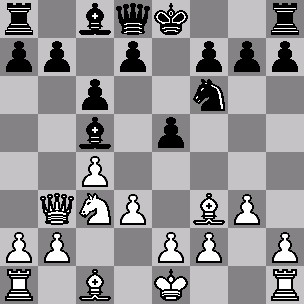
9.0–0?! What a pity! The young player does not accept the challenge, striving for a quiet position. He could fight for the initiative by 9.g4! d6 (9...d5!? deserves attention, too) 10.g5. Now there are two possible knight retreats: A) 10...Ng8, and now A1) 11.Na4 Qa5+ (11...Ne7?! 12.Nxc5 dxc5 13.Be4! 0–0 14.h4 Vallejo Pons,F-Gelfand,B/Pamplona 1999) 12.Kf1 (bad is 12.Bd2? Bxf2+!) 12...Bb4!? (12...Bh3+ 13.Bg2 Bxg2+ 14.Kxg2 Qc7 15.f4 with the initiative) 13.a3 Bd2 with complex and non-standard play; A2) 11.Ne4!? 11...Bb6 12.Qa3 Bc7 13.c5 (13.Bd2 Ne7 14.Bb4 Nf5) 13...dxc5 (13...d5 14.Nd6+) 14.Qxc5 Ne7 with unclear play, Zvjaginsev,V-Svidler,P/blitz 2001; B) 10...Nd7 11.Ne4 0–0 12.Rg1 Bb6, with a complicated position, Aronian,L-Gelfand,B/Saint Vincent 2005.
In the game Volkov-Zvjaginsev I doubt the move 10.Be2. The bishop is inactively placed here, Black is close to equality.
Motylev-Kramnik - a dynamic equality. I am sure that Kramnik is quite familiar with this position.
Rublevsky-Dreev - the situation here is opposite: judging by the clock, White is more familiar with this line. It is too early to draw any conclusions, the position is complex.
Khalifman preferred to take a break after yesterday's blow - the final position in his game with Bareev is theoretical.
9...0-0 10.Bg5 Be7 Of course, not 10...h6 in view of 11.Bxf6 Qxf6 12.Ne4 Qe7 13.Nxc5 Qxc5, and White has a stable plus, while Black lacks any counterplay ideas.
11.Rfd1 d6 12.Rac1. Just a move. 12.d4 is more logical.
12...h6 Morozevich lost on time. He hadn't managed to wake up in time! A familiar by one of the Petersburg championships situation - in that case Lugovoi's loss by forfeit prevented him from becoming the city champion in the end...
13.Bd2 Each side achieved what was desired: White got a minimal advantage, and Black has prospectives of initiating a complex struggle. Now both players will start maneuvering in order to seize control over the central squares.
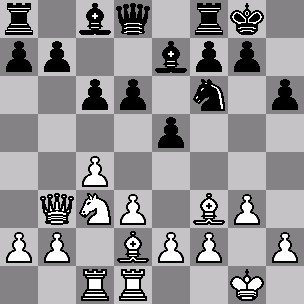
This is characteristc for modern chess - real struggle just does not occur sometimes. It is exactly what happened today in the game Motylev-Kramnik. I am sure that the final position is saved somewhere on Volodya's computer, and Alexander, playing in a hopeful mood, spoiled his second White in the tournament. One can only find consolation in the fact that it is very hard to beat such players as Kramnik or Dreev even having guessed the opening right.
13...Qc7 14.Bg2 Bf5 15.Qa4. Finally White has worked out some plan: he wants to play b2-b4-b5 and extend the range of his light-squared bishop.
15...Qd7 16.b4 a6. 16...Bh3 is also possible, but exchaning the bishops is not in White's favor, and he can avoid it by a simple 17.Bh1.
17.Qb3 b5. A fairly unexpected decision! Now White can add pressure on light squares by playing 18.a4 with a minimal advantage... Well, now I think I was wrong: 18.a4 is strongly met by 18...Be6 19.Ne4 Ne4 20.Be4 d5, and it is Black who has a minimal advantage. Correct is 18.Ne4 Ne4 19.Be4 with approximately even position.
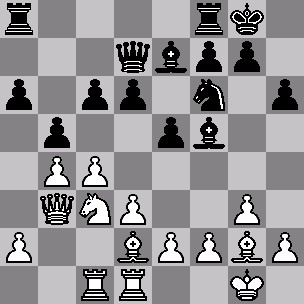
18.a4? Be6! A strong move! Now White will struggle for equality. Here is a sample line: 19.axb5 axb5 20.Ne4 Nxe4 21.Bxe4 d5 22.cxd5 cxd5 23.Bg2, and Black has a pleasant choice between 23...d4 24.Qb1 Bd5 and a simple play on the a-file starting with 23...Ra4 or 23...Ra6.
19.Qb2?! White's play is surprisingly passive. Now his position becomes hopelessly worse.
Volkov-Zvjaginsev: after White's 23rd move a highly interesting position aarose - Black is about to begin the attack, but it is unclear whether it will succeed.
19...d5. Peter plays very solidly, keeping a slight advantage on the whole board. I would not be able to resist the temptation to strengthen my positions in the center by 19...bxc4 20.Nb1, and here Black has a multiple choice of promising initiative continuations: 20...d5, 20...Bg4, 20...Bh3 (20.dxc4 Bxc4 21.Ne4 Nxe4 22.Bxe4 Bd5, keeping an extra pawn).
Rublevsky-Dreev: an original position arose out of the opening. Dreev's maneuver 12...Qf6 looks dubious. As a consequence, Rublevsky obtained an advantage, but there is still a long way to a victory.
20.cxd5 cxd5 21.axb5 axb5 22.Ra1 Rfc8 23.Rdc1 Bh3. It is not easy to show precisely how Black can develop his advantage. I prefer a healthy strengthening move 23...Bd6. Maybe Peter did not like that this moves removes an overprotection from the d5-pawn, but inserting 23...Bh3 24.Bh1 has the same disadvantage...
24.Bh1 Rxa1 25.Rxa1 d4 26.Ne4 Nd5 Black maintains the pressure. Peter is playing very well.
Volkov just made a horrible blunder and must lose - instead of 26.g3?? he should have played 26.Kg1 Ne5, and now 27.R2d5 followed by 28.Nd4 or even 27.Nd4 at once 27...Rg5 28.g3 repulse the attack with an advantage for White.
27.Qa3 This indicates White's troubles. However, better was 27.e3.
27...Qc7! The queen is ready to penetrate into the enemy camp.
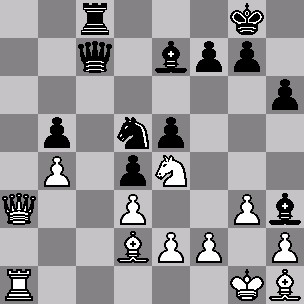
28.Rc1?? The young player breaks under pressure and commits a blunder, but the position was already unpleasant. Of course, more stubborn is 28.Bf3, protecting the e2-pawn in advance.
28...Bxb4 The b-pawn will now promote inevitably.
29.Qb2 Qe7 30.Nf6+. The exchanges only simplify Black's task.
30...gxf6 31.Rxc8+ Bxc8 32.Bxd5 Bxd2 33.Qxd2 Qc5 The queen goes to c3, and he can also make a prophylactic move Kg7 at will. White resigned. 0-1
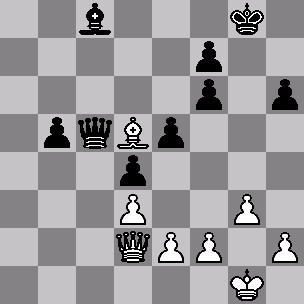
I would like to express gratitude to Alexander Borisovich Roshal for dictating the moves on a phone when the official broadcasting suffered yet another clinical death in just three starting rounds.
Back to the Superfinal main page
